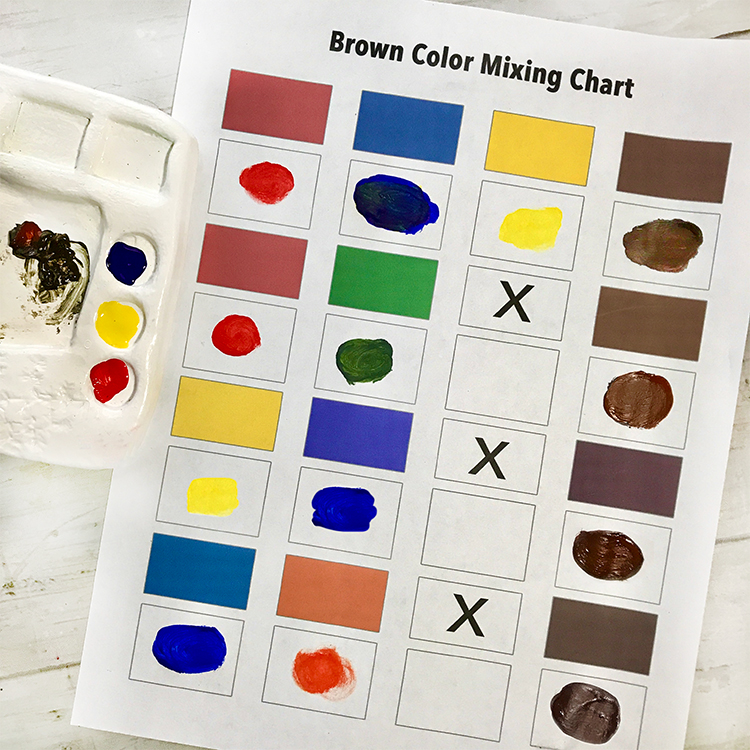How to Make Brown Paint
Creating the perfect shade of brown can be a versatile skill for any artist. Whether you’re painting landscapes, portraits, or abstract works, having a range of brown tones at your disposal can greatly enhance your artistic expression. In this comprehensive guide, we’ll explore various methods for making brown paint using different mediums and color combinations.
Mixing Brown with Primary Colors
One of the most straightforward ways to create brown paint is by mixing the three primary colors: red, yellow, and blue. By varying the ratios of these colors, you can achieve a wide array of brown tones.To start, mix equal parts of red, yellow, and blue on your palette. Use a palette knife or brush to blend the colors together until you achieve a rich, chocolatey brown. This will serve as your base color.Next, separate the mixed brown into four equal piles. In one pile, add more yellow to create a warmer, golden brown. In another, add more red for a reddish-brown. The third pile can be lightened with white to make a lighter tan or beige shade. Finally, add more blue to the fourth pile to create a cooler, grayish-brown.By experimenting with the ratios of primary colors, you can create a diverse range of browns, from earthy ochres to deep umbers.
Mixing Brown with Complementary Colors
Another approach to making brown is by mixing complementary colors, which are colors that sit opposite each other on the color wheel. When complementary colors are combined, they create a neutral brown tone.Some examples of complementary color pairs that can be used to make brown include:
- Blue and orange
- Purple and yellow
- Green and red
To mix brown using this method, start with a warm color, such as orange or yellow, and gradually add its complementary cool color, like blue or purple, until you achieve the desired brown shade. Adjust the ratios to create warmer or cooler variations of brown.
Using Premixed Browns
If you prefer a more straightforward approach, you can use premixed brown paints, such as Burnt Sienna or Burnt Umber, and modify them to suit your needs. These paints are typically made by mixing various pigments, including earth tones and black.To lighten a premixed brown, simply add white paint. For a darker, richer brown, mix in a small amount of black or a complementary color, such as blue for a cooler brown or red for a warmer tone.Premixed browns can also be combined with each other or with primary colors to create unique shades. Experiment with different ratios and mixes to find the perfect brown for your painting.
Glazing and Layering Techniques
Both oil and acrylic paints can be thinned down to create glazes, allowing you to build up layers of color and achieve a multi-faceted brown hue.For oil paints, use a medium like linseed oil or a glazing medium to thin the paint. Apply the glaze in thin, transparent layers, allowing each layer to dry before adding the next. This technique creates depth and complexity in the brown tones.With acrylics, you can use a glazing medium or simply thin the paint with water. Apply the glaze in the same manner as with oils, layering the paint to create a rich, layered effect.When using glazing techniques, start with a lighter base color and gradually build up the brown tones. This allows you to control the intensity and transparency of the final color.
Mixing Brown with Oils
When working with oil paints, there are two main methods for mixing brown: the palette method and the glazing/layering method.Palette Method:
- Start with small dabs of red, yellow, and blue on your palette.
- Use a palette knife or brush to mix the colors together, spreading the paint thin to gauge the hue, value, and saturation.
- Pull in other colors to lighten, darken, or adjust the undertones of the brown.
- Test the mixed color on a practice surface to ensure it achieves your desired effect.
Glazing and Layering Method:
- Mix your colors and thin them with a solvent or medium.
- Apply the thinned paint directly to your surface in thin, transparent layers.
- Allow the lower layers to show through, creating depth and interest.
- Assess the color and make adjustments as needed by adding more paint or medium.
Mixing Brown with Acrylics
Acrylic paints can be mixed using similar methods to oil paints, with a few variations due to their faster drying time.Palette Method:
- Start with dabs of red, blue, and yellow on separate areas of your palette.
- Use a palette knife to scrape and blend the colors together in the center of the palette.
- Push the colors under the blade until they form a single shade of brown.
- Add more of each color as needed to achieve the desired brown tone.
Glazing and Layering Method:
- Thin acrylic paints with a glazing medium or water to create transparent glazes.
- Apply the glazes in thin layers directly to your surface, allowing each layer to dry before adding the next.
- The thinned paint will behave similarly to watercolors, allowing you to build up layers of brown tones.
Mixing Light Brown
Light brown shades, such as tan, beige, or khaki, can be easily created by adding white paint to any brown mixture. The amount of white you add will determine the lightness of the final color.When mixing light brown, start with a small amount of white and gradually increase it until you achieve the desired tone. Keep in mind that adding too much white can make the brown appear chalky or desaturated, so be mindful of the balance.You can also start with a premixed light brown, such as Titanium White mixed with Burnt Sienna or Burnt Umber, and adjust the color as needed by adding more white or a touch of a primary color.
Why Isn’t Brown on the Color Wheel?
Brown is not typically included on the standard color wheel because it is considered a neutral color, similar to black, white, and gray. However, brown can be created by mixing various colors together, and its position on the color wheel would depend on its undertones.Essentially, brown is a dark version of red, orange, or yellow, depending on the specific shade. If the color wheel included shades and tints, brown would be placed between red and orange, or between yellow and orange, depending on its warmth or coolness.The absence of brown on the color wheel does not diminish its importance in the world of art and design. In fact, brown is a versatile and essential color that can be used to create depth, balance, and harmony in a wide range of artistic works.
FAQ Section
What colors make brown paint?
Brown can be made by mixing the three primary colors (red, yellow, and blue) or by mixing complementary colors (colors opposite each other on the color wheel, such as blue and orange, purple and yellow, or green and red).
How do I make light brown paint?
To make light brown paint, add white paint to any brown mixture. Start with a small amount of white and gradually increase it until you achieve the desired tone. You can also start with a premixed light brown, such as Titanium White mixed with Burnt Sienna or Burnt Umber, and adjust the color as needed.
Can I use black to make brown paint?
Yes, you can use black paint to darken and mute other colors, creating a brown tone. Mix black with red, yellow, or orange to create different shades of brown.
What is the best way to mix brown paint?
The best way to mix brown paint depends on your preferred method and the medium you are using. Some effective methods include:
- Mixing the three primary colors (red, yellow, and blue) in varying ratios
- Mixing complementary colors (e.g., blue and orange, purple and yellow, green and red)
- Using premixed browns and modifying them with white, black, or other colors
- Glazing and layering techniques to build up depth and complexity in the brown tones
Can I use brown paint straight from the tube?
Yes, you can use premixed brown paints straight from the tube, such as Burnt Sienna or Burnt Umber. These paints are typically made by mixing various pigments, including earth tones and black. You can modify them by adding white, black, or other colors to achieve the desired shade.
How do I make a specific shade of brown paint?
To make a specific shade of brown, start with a base color and gradually add other colors to adjust the undertones and value. For example:
- For a warmer brown, add more red or yellow
- For a cooler brown, add more blue
- To lighten the brown, add white
- To darken the brown, add black or a complementary color
Experiment with different color combinations and ratios until you achieve the exact shade you desire.
Can I use brown paint for skin tones in portraits?
Yes, brown paint can be used as a base for skin tones in portraits. However, it’s important to note that human skin tones are complex and vary greatly depending on factors such as ethnicity, age, and exposure to the sun. To accurately capture skin tones, you may need to mix a variety of colors, including browns, reds, yellows, and whites.
What is the difference between oil and acrylic brown paint?
The main differences between oil and acrylic brown paint are:
- Drying time: Oil paints dry slowly, allowing for more blending and layering, while acrylics dry quickly.
- Thinning: Oil paints are thinned with solvents or mediums, while acrylics can be thinned with water or acrylic medium.
- Glazing: Both oil and acrylic paints can be thinned to create glazes, but the techniques differ slightly due to the drying times.
Ultimately, the choice between oil and acrylic brown paint comes down to personal preference and the desired effect.
Can I mix brown paint with other colors to create new colors?
Yes, you can mix brown paint with other colors to create new colors. Brown is a neutral color that can be used to mute or darken other colors. For example:
- Mix brown with blue to create a muddy green
- Mix brown with red to create a reddish-brown or maroon
- Mix brown with yellow to create an earthy, ochre-like color
Experiment with different color combinations and ratios to discover unique color mixtures.
How do I store brown paint?
To store brown paint, keep it in an airtight container in a cool, dry place away from direct sunlight. Make sure the lid is tightly sealed to prevent the paint from drying out. When ready to use the paint again, stir it well to reincorporate any settled pigments.
Can I use brown paint for mixed media projects?
Yes, brown paint can be used in a variety of mixed media projects, such as collage, printmaking, and mixed media painting. Its versatility allows it to be combined with other media, such as ink, charcoal, or pastel, to create unique and expressive artworks.



